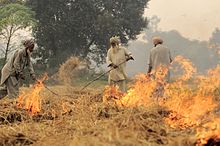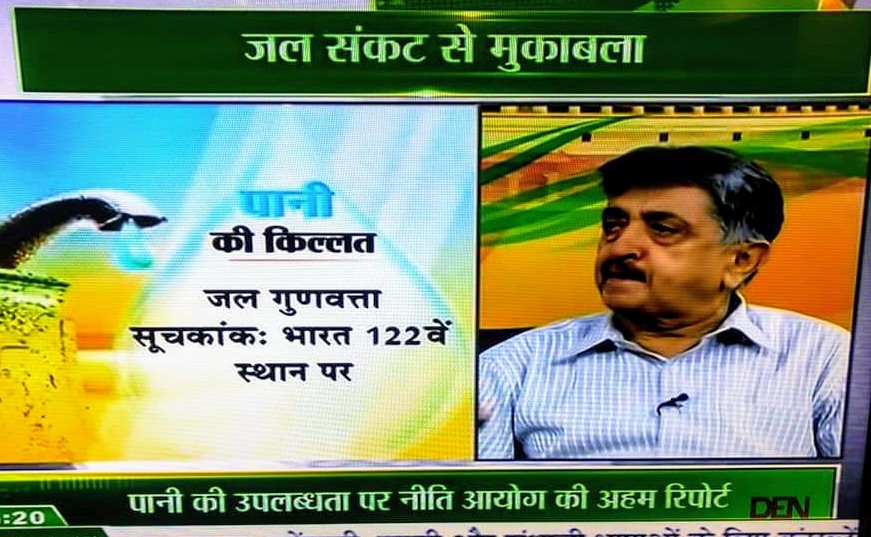Stubble Burning Fact and Fiction
Now that the harvesting season is around the corner it’s important to examine the issue of stubble burning. There’s a tremendous amount of misconception and misinformation floating around on Stubble Burning. Common people and Media squarely blame the farmers. But gleaning through Wikipedia as a proof of what one has been saying, is that it’s a world wide phenomenon. The pollution due to Stubble Burning is not as acute as is made out to be. Also, hold your breath, there are some beneficial effects. This is not to recommend Stubble Burning at all, but to introspect as well, think. Can one month of this activity cause pollution all the year round? Who are the other culprits hiding behind the farmers backs. What are the solutions?
According to Wikipedia:
Stubble burning is intentionally setting fire to the straw stubble that remains after grains, like paddy, wheat, etc., have been harvested. The practice was widespread until the 1990s, when governments increasingly restricted its use.
The burning of stubble, contrasted with alternatives such as ploughing the stubble back into the ground or collecting it for industrial uses, has a number of consequences and effects on the environment.
Generally helpful effects
- Kills slugs and other pests.
- Can reduce nitrogen tie-up.
Generally harmful effects
- Loss of nutrients
- Pollution from smoke
- Damage to electrical and electronic equipment from floating threads of conducting waste
- Risk of fires spreading out of control
There is a perception that stubble burning contributes to atmospheric CO2. However carbon dioxide releases are only slightly greater than those from natural decomposition.
Attitudes to stubble burning
- Stubble burning has been effectively prohibited since 1993 in England and Wales. A perceived increase in blackgrass, and particularly herbicide resistant blackgrass, has led to a campaign by some arable farmers for its return.
- In Australia stubble burning is “not the preferred option for the majority of farmers” but is permitted and recommended in some circumstances. Farmers are advised to rake and burn windrows, and leave a fire break of 3 metres around any burn off.
- In the The burning of stubble, contrasted with alternatives such as ploughing the stubble back into the ground or collecting it for industrial uses, has a number of consequences and effects on the environment.[1]
Generally helpful effects Edit
Kills slugs and other pests.
Can reduce nitrogen tie-up.
Generally harmful effects Edit
Loss of nutrients
Pollution from smoke
Damage to electrical and electronic equipment from floating threads of conducting waste
Risk of fires spreading out of control
There is a perception that stubble burning contributes to atmospheric CO2. However carbon dioxide releases are only slightly greater than those from natural decomposition.Attitudes to stubble burning Edit
Stubble burning has been effectively prohibited since 1993 in England and Wales. A perceived increase in blackgrass, and particularly herbicide resistant blackgrass, has led to a campaign by some arable farmers for its return.
In Australia stubble burning is “not the preferred option for the majority of farmers” but is permitted and recommended in some circumstances. Farmers are advised to rake and burn windrows, and leave a fire break of 3 metres around any burn off. - In the United States, fires are fairly common in mid-western states, but some states regulate the practice, e.g.
In the European Union, the Common Agricultural Policy strongly discourages stubble burning.
In China, there is a government ban on stubble burning; however the practice remains fairly common.
In northern India, despite a ban by the Punjab Pollution Control Board, stubble burning is still practiced. Authorities are starting to enforce this ban more proactively.
Stubble burning is allowed by permit in some Canadian provinces, including Manitoba where 5% of farmers were estimated to do it in 2007.
Stubble burning in IndiaBurning of rice residues after harvest, to quickly prepare the land for wheat planting, around Sangrur, Punjab, India
Stubble burning in Punjab and Haryana in northwest India has been cited as a major cause of air pollution in Delhi. In late September and October each year, farmers mainly in those two states burn an estimated 35 million tons of crop waste from their paddy fields after harvesting, as a low-cost straw-disposal practice to reduce the turnaround time between harvesting and sowing for the second (winter) crop. Smoke from this burning produces a cloud of particulates visible from space, and has produced a “toxic cloud” in New Delhi, resulting in declarations of an air-pollution emergency.[16] For this, the NGT (National Green Tribunal) slapped a fine of Rs. 2,00,000 on the Delhi Government for not filing an action plan providing incentives and infrastructural assistance to farmers to stop them from burning crop residue to prevent air pollution.Although harvesters are available such as the Indian-manufactured “Happy Seeder” that shred the crop residues into small pieces and uniformly spread them across the field, as an alternative to burning the crops, farmers complain that the cost of these machines is prohibitive compared to burning the fields, fires are fairly common in mid-western states, but some states regulate the practice, e.g..
- In the European Union, the Common Agricultural Policy strongly discourages stubble burning.
- In China, there is a government ban on stubble burning; however the practice remains fairly common.
- In northern India, despite a ban by the Punjab Pollution Control Board, stubble burning is still practiced. Authorities are starting to enforce this ban more proactively.
- Stubble burning is allowed by permit in some Canadian provinces, including Manitoba where 5% of farmers were estimated to do it in 2007.
Stubble burning in India
Stubble burning in Punjab and Haryana in northwest India has been cited as a major cause of air pollution in Delhi. In late September and October each year, farmers mainly in those two states burn an estimated 35 million tons of crop waste from their paddy fields after harvesting, as a low-cost straw-disposal practice to reduce the turnaround time between harvesting and sowing for the second (winter) crop. Smoke from this burning produces a cloud of particulates visible from space, and has produced a “toxic cloud” in New Delhi, resulting in declarations of an air-pollution emergency. For this, the NGT (National Green Tribunal) slapped a fine of Rs. 2,00,000on the Delhi Government for not filing an action plan providing incentives and infrastructural assistance to farmers to stop them from burning crop residue to prevent air pollution.
Although harvesters are available such as the Indian-manufactured “Happy Seeder” that shred the crop residues into small pieces and uniformly spread them across the field, as an alternative to burning the crops, farmers complain that the cost of these machines is prohibitive compared to burning the fields


